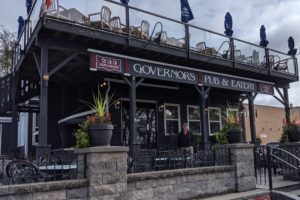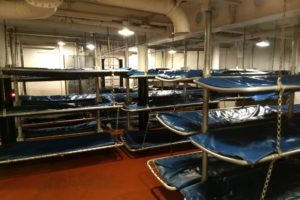So what do we call a trip that takes us north close to the Canadian border and then a little west? The title we came up with is Northern Plains, and it includes North and South Dakota and parts of eastern Montana and Wyoming. The land is flat in the eastern part of this area and is good for growing corn, soybeans, and alfalfa. The western part of the area is desert-like and highlights the Badlands where the Natives said is was “bad to live.” Why did we come here on this trip? These states weren’t closed down by Covid-19!

Then the question is, why was our first stop Jamestown, which is about an hour west of Minnesota on Hwy. 94 that runs east to west in the lower third of the state.
Practically, our challenge was to find a campground with sites available over the Labor Day weekend. In Minnesota and North Dakota, if a family doesn’t have a weekend cabin at a lake to go to when the weather is nice, it goes to a local campground. Jamestown’s city campground had a site where we could stay for 5 nights, but we had to leave on Saturday morning of the holiday weekend since our site was already reserved for Saturday and Sunday nights. (More about what we did after Jamestown in a future post.)
Emotionally, our goal was to see the largest buffalo in the world.

This post is about our campground, Jamestown itself, and an early fort that has a connection to Kevin Costner. Then we’ll take a look at the buffaloes/bison here, which was the original draw to Jamestown.
campground

North of Jamestown a dam was built along the James River to create a reservoir that provided a large lake for boating and fishing—and provided space for our campground.

The James River (also called Jim River or Dakota River) starts in central North Dakota, and flows in a generally south-southeasterly direction across South Dakota to join the Missouri River about 710 miles away.





breakfast out
For years we’ve gone out for breakfast on Friday mornings. As we drove into Jamestown the first time, we saw this truck stop restaurant filled with lots of trucks in the parking lot next to it—a good sign.


Well-known residents of Jamestown from years ago are Peggy Lee and Louis L’Amour. Just thought you’d like to know.
Fort Seward
As you know by now, I love history because it gives us insight to the people we meet and the land we’re seeing. And if we don’t know and learn from the mistakes of our history, we may repeat them. So in the Northern Plains states, which has such a different historical and geographical background from where we’ve been before, we want to know what happened here as our nation was settled and as it expanded.
And Fort Seward has a connection to Kevin Costner and the movie Dances With Wolves.
Close to the James River inside the city limits is Fort Seward whose troops protected the area from June 3, 1872, to September 30, 1877. Let’s walk around and learn more about why the U.S. troops were stationed here.





The post was built on a bluff overlooking the point where the James River and the Pipestone Creek meet.
While the Sioux had recently moved to reservations, occasional raiding parties and intermittent warfare further west indicated a need for military protection for Northern Pacific railroad workers and property. This transcontinental railroad operated across the northern tier of the western United States from Minnesota to the Pacific Northwest from 1864 to 1970.
Fort Seward was established along the rail line mainly to serve as a depot for supplies going to Fort Totten, 81 miles north (which we plan on seeing). Other fort functions included aiding U.S. marshals’ enforcement of federal laws in the Jamestown area, supporting the telegraph company in keeping its lines open, and serving as a military mail and message transfer point. Soldiers also escorted the paymaster and other officers and accompanied herds of beef cattle on their way west to other posts on the Missouri River.
Built mainly of lumber, the fort buildings included quarters for troops and officers, a hospital, a guard house, storehouses, stables, a granary, a bake house, offices, and workshops. Their gardens were less than a mile away.
During the summer of 1872, some 500 railway workers lived in tents near to Fort Seward. After railroad construction stalled at Bismarck in 1873, the need for the fort’s military protection decreased. The fort was abandoned in 1877. Lumber from the buildings was shipped north to Fort Totten.



The fort also had a Gatling gun (a rapid-fire weapon invented in 1861 by Richard Jordan Gatling and a forerunner of the modern machine gun) that was returned to the war department in 1876 since they no longer had need for it and they didn’t have ammunition for it.



Laudanum: Mixing alcohol with a bit of opium gives you laudanum, one of the common medicines in the late 1800s. It was used by doctors to treat everything from coughs to diarrhea. It also was used as a heavy duty pain killer. Every bit as addictive as today’s opioids, it was much more available to soldiers and civilians in the 1870s.
Patent medicines: Patent medicines available at stores in Jamestown were made from cocaine, morphine, or opium dissolved in high concentrates of alcohol.
reenactors and Kevin Costner


The reenactors provided their own personal uniforms and equipment and served as extras in the fort and battle scenes. The 20th Infantry even provided a replica of what a surgical table of the American Civil War or Indian War Period may have looked like. The smears of red paint on the table may have been placed there as a prop to mimic Kevin Costner’s blood.


Now on to what we learned about the buffaloes/bison that roamed the Northern Plains.




